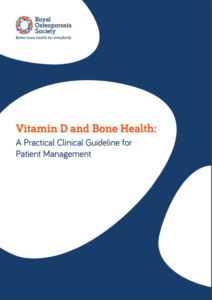International Guidelines and Recommendations
Click on the appropriate heading below to view full information
Recommendations for at risk groups
-
The Food Safety Authority of Ireland (FSAI) recommends that a daily 5µg vitamin D only supplement should be given to all healthy term breast-fed infants from birth to 12 months.1
-
Recently, following advice from EFSA (2014) there has been a change in EU legislation governing the composition of infant formula which will result in a significant increase in their vitamin D content. For this reason, the national policy on vitamin D supplementation for infants in Ireland is being revised to include an updated recommendation for vitamin D supplementation in formula fed infants and those who are fed a combination of breast milk and formula.1
- The Royal Osteoporosis Society in the UK (ROS) has identified the following adult groups at risk of vitamin D deficiency:2
- Older people, aged 65 years and over
- People who have low or no exposure to the sun, for example those who cover their skin for cultural reasons, who are housebound or who are confined indoors for long periods
- People who have darker skin, for example people of African, African-Caribbean or South Asian origin, because their bodies are not able to make as much vitamin D
Recommendations on screening
- The Endocrine Society ‘Clinical Practice Guideline on Evaluation, treatment and prevention of vitamin D deficiency’ lists indications for 25(OH)D measurement (candidates for screening):3
Indications for 25(OH)D measurement include:
- Rickets
- Osteomalacia
- Osteoporosis
- Chronic kidney disease
- Hepatic failure
- Malabsorption syndromes
- Cystic fibrosis
- Inflammatory bowel disease
- Crohn’s disease
- Bariatric surgery
- Radiation enteritis
- Hyperparathyroidism
- Medications
- Antiseizure medications
- Glucocorticoids
- AIDS medications
- Antifungals, e.g. ketoconazole
- Cholestyramine
- Obese children and adults (BMI 30 kg/m2)
- Granuloma-forming disorders
- Sarcoidosis
- Tuberculosis
- Histoplasmosis
- Coccidiomycosis
- Berylliosis
- Some lymphomas
The Endocrine Society suggests that all adults who are vitamin D deficient be treated with 50,000 IU of vitamin D once a week for 8 weeks to achieve a blood level of 25(OH)D above 30 ng/ml (75nmol/l), followed by maintenance therapy of 1500–2000 IU/day.3
Recommendations for treatment of vitamin D deficiency
The Royal Osteoporosis Society (ROS) recommendations for treatment of vitamin D deficiency:2
1. Loading regimens for treatment of deficiency up to a total of approximately 300,000 IU over several weeks.
2. Maintenance regimens may be considered one month after loading with doses equivalent to 800 to 2000 IU daily (occasionally up to 4,000 IU daily), given either daily or intermittently at a higher equivalent dose.
- The American Geriatrics Society Consensus Statement on Vitamin D for the Prevention of Falls and their Consequences recommends a minimum dose of 1000 IU vitamin D per day4
- The American Academy of Paediatrics (AAP) currently recommends that babies younger than 12 months old need 400 IU of vitamin D each day. They also recommend that toddlers, older children, and adolescents need 600 IU of vitamin D each day. 6
- The Canadian Paediatric Society recommends babies who are breastfed should get 400 IU (international units) per day. If they have one or more risk factors (on top of breastfeeding), they require an additional 400 IU/day. They also recommend that babies in northern communities or who have other risk factors should get 800 IU per day, year-round. 7
- The Scientific Advisory Council of Osteoporosis Canada recommends that those over 50 or younger adults at high risk (with osteoporosis, multiple fractures, or conditions affecting vitamin D absorption) should receive 800-2,000 IU daily.5
- The Evidence-Based Recommendations from the Cystic Fibrosis Foundation recommend an initial dose of 400-500 IU vitamin D3 per day from birth to 12 months, rising to 800-1000 IUvitamin D3 per day from 1-10 years of age, and to 800-2000 IU vitamin D3 per day for 10 years and over8

